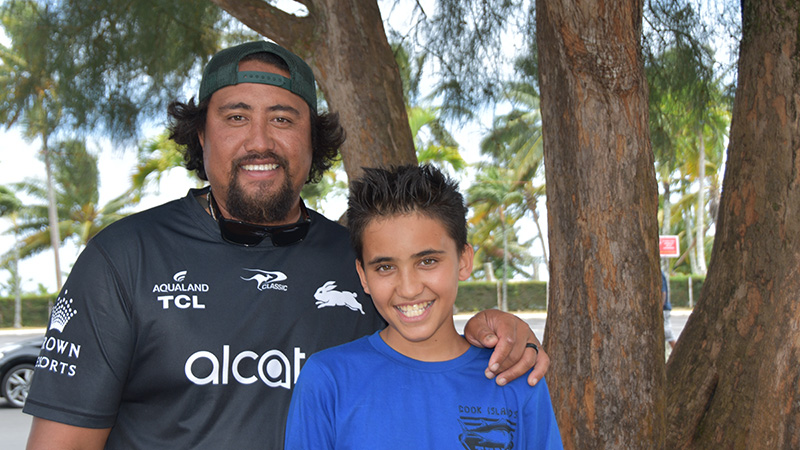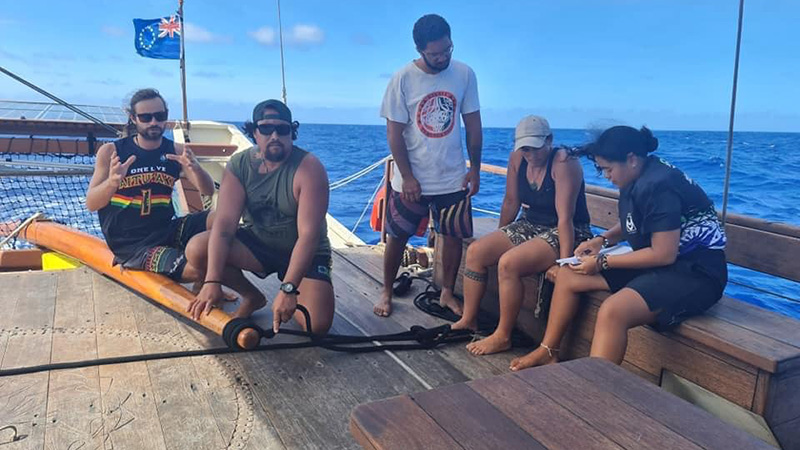Sailing with the mana of Ui Tupuna
Saturday 13 November 2021 | Written by Melina Etches | Published in Features

First time Vaka Marumaru Atua voyager Arerau Maao Jr and his son Dominik Maao who also accomplished an ocean voyage on the vaka last year. 21111001.
As a young child Arerau Maao Jr, now in his 30s, had visions of sailing on a vaka. Last week he accomplished just that, sailing on the Vaka Marumaru Atua for the first time from his home island of Aitutaki to Rarotonga.
Departing Aitutaki there were unfavourable winds, the vaka went about 36 miles north east of Aitutaki then turned down heading for Rarotonga. This is when the crew led by master navigator and captain of the voyage Peia Patai turned off all modern systems and activated traditional navigation – the guidance of the elements.
Maao was thrilled that the voyage to Rarotonga would operate on traditional navigation practices since he had particularly wanted to “connect with our tupuna, especially on how they sailed the oceans back in their days and their way of navigating, I wanted to experience that too”.
He was also elated to be given the opportunity to take control of the oe (steerer). “I felt so connected to our ancestors when I was steering the oe, I felt like I was at home…”
Sailing blind at night was one of his highlights. “You can’t see anything at night just the stars, you just hear the waves, and those moments really made me think about the mana of our Ui Tupuna, back to how it used to be. It was a powerful feeling of connection and respect, that’s what I felt out there.”
Learning about the stars, the current and how to read the elements were also some of the highlights.
“You’re always looking for the next one for the next sign. Out there, there’s not a lot to do, just the smell of salt water, watching the sunrise, the sunset, the stars… I felt so blessed and connected.”

Although the rain, waves and the wind were challenging at times particularly for a first-time ocean voyager, Maao felt fine and managed to complete the trip without getting sea sick.
After a whopping 39-hour sail – usually would take about 22 hours – Marumaru Atua arrived at Rarotonga near midnight on Friday night. “I didn’t really care how long the voyage would take, I just felt however long it took, it was meant to be…”
Maao’s earliest memories of vaka was seeing the Vaka Takitumu and Vaka Teau o Tonga in Aitutaki back in the 90s. That sparked his dream to experience a voyage on the seas.
“I did ask my dad back then but he wouldn’t let me go,” he recalls
Last year in November, Maao and his wife Tamara allowed their 11-year-old son Dominik to sail on Marumaru Atua to Rarotonga – his first island to island voyage, beating his dad to his vaka dream.
“I allowed my son to do the vaka voyage last year so he could experience it. When my son did it I felt that I wanted to do it even more, to do it for myself… and now we both have,” says Maao.
Both father and son say they have enjoyed their voyages and are keen to learn more and set sail on another seafaring cultural experience.
The vaka had sailed to Aitutaki using traditional navigation for the Bi-centennial Arrival of Christianity celebrations and had arrived there on October 22.
Navigator Peia Patai says the nearly 24-hour voyage to Aitutaki had had favourable weather and things were easier.
But for this trip back to Rarotonga, the course directions and conditions were different and for the new crew students onboard, there was a lot to learn which proved a bit of challenge for them.
“I’m amazed that there is a lot of interest out there from our young generation to learn about vaka voyaging and we are passing the knowledge on to them,” says Patai.
He is happy with the progress of the sailing students. “They learn the basics with the modern apps we have today and we allow notebooks… in my day you had to keep it all in your head.”
“We can use our understanding to help them learn more, the next step is to dig a bit deeper, they need to be more comfortable and confident.
“I want them to feel the feeling of ‘when you pull the island out of the ocean’ (when you first sight land from out at sea).”
Although he is pleased and encouraged with the youth participation, Patai believes that there is a need to encourage the older generation to learn and participate in vaka voyaging.
The youth tend to leave, “they go overseas for further education, careers etc.,” he says.
“With older people they’ve done their time overseas, they’re back to live here and are here to stay, we need them to get involved too … they can hold the knowledge.”
The Cook Islands Voyaging Society (CIVS) has one more programme to deliver for the 2021 calendar year, a UNESCO funded crew training programme called “Teretereanga Vaka Programme” which consists of both theory and practical sessions over a four-week period split in two stages.
Nooroa (Bim) Tou, a CIVS board member, says the plan is for the training programme to be delivered by Peia Patai Sr to train Rarotonga crew starting with theory sessions on November 22, 2021 and the practical training sailing on the vaka to Aitutaki around November 28.
The Marumaru Atua will then be dry docked in Arutanga wharf in Aitutaki during the cyclone season.
Stage two of the training programme will start with theory lessons conducted in Aitutaki next year after the cyclone season in April (date to be confirmed), followed by a practical session of sailing to Rarotonga.












































